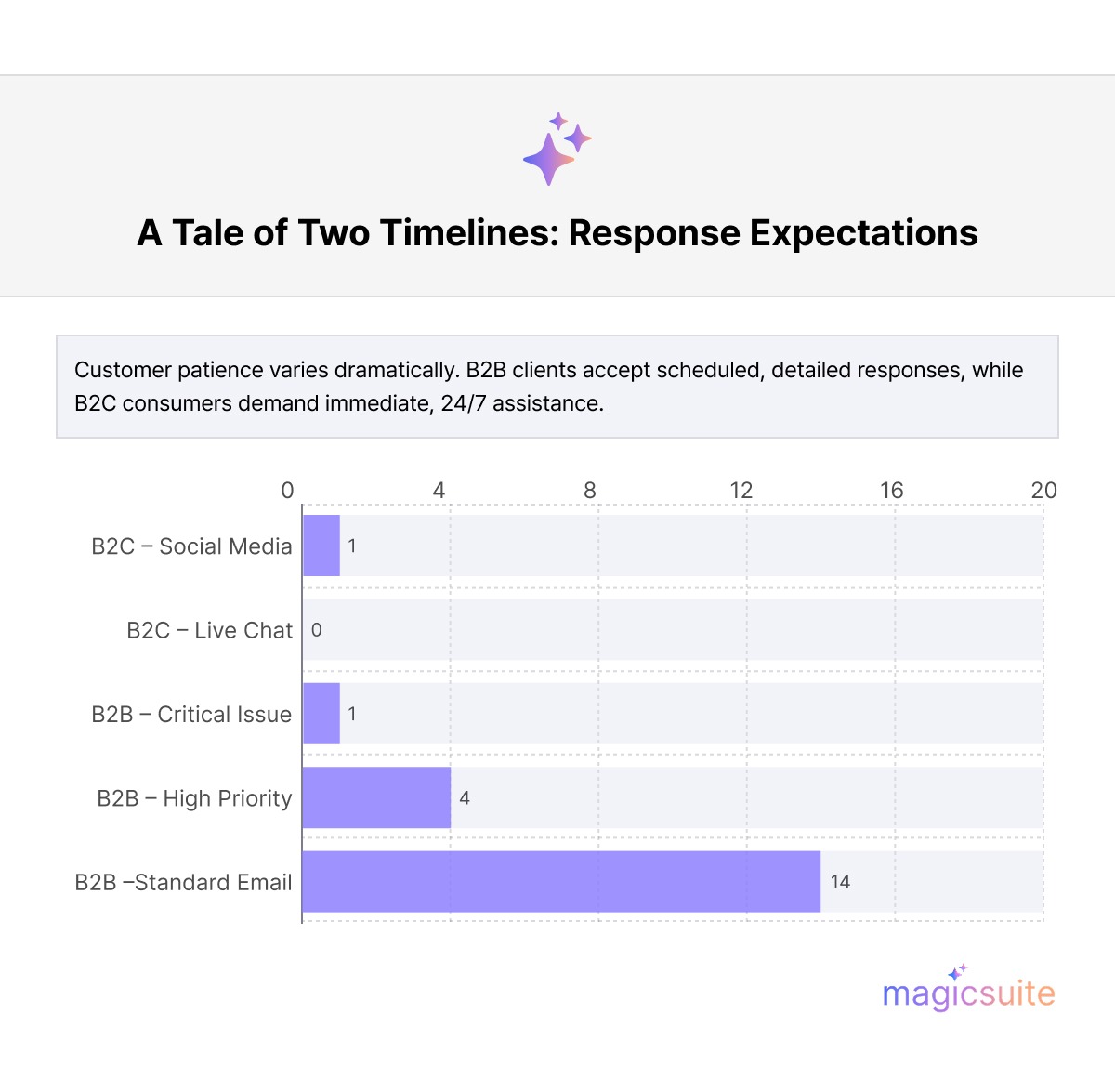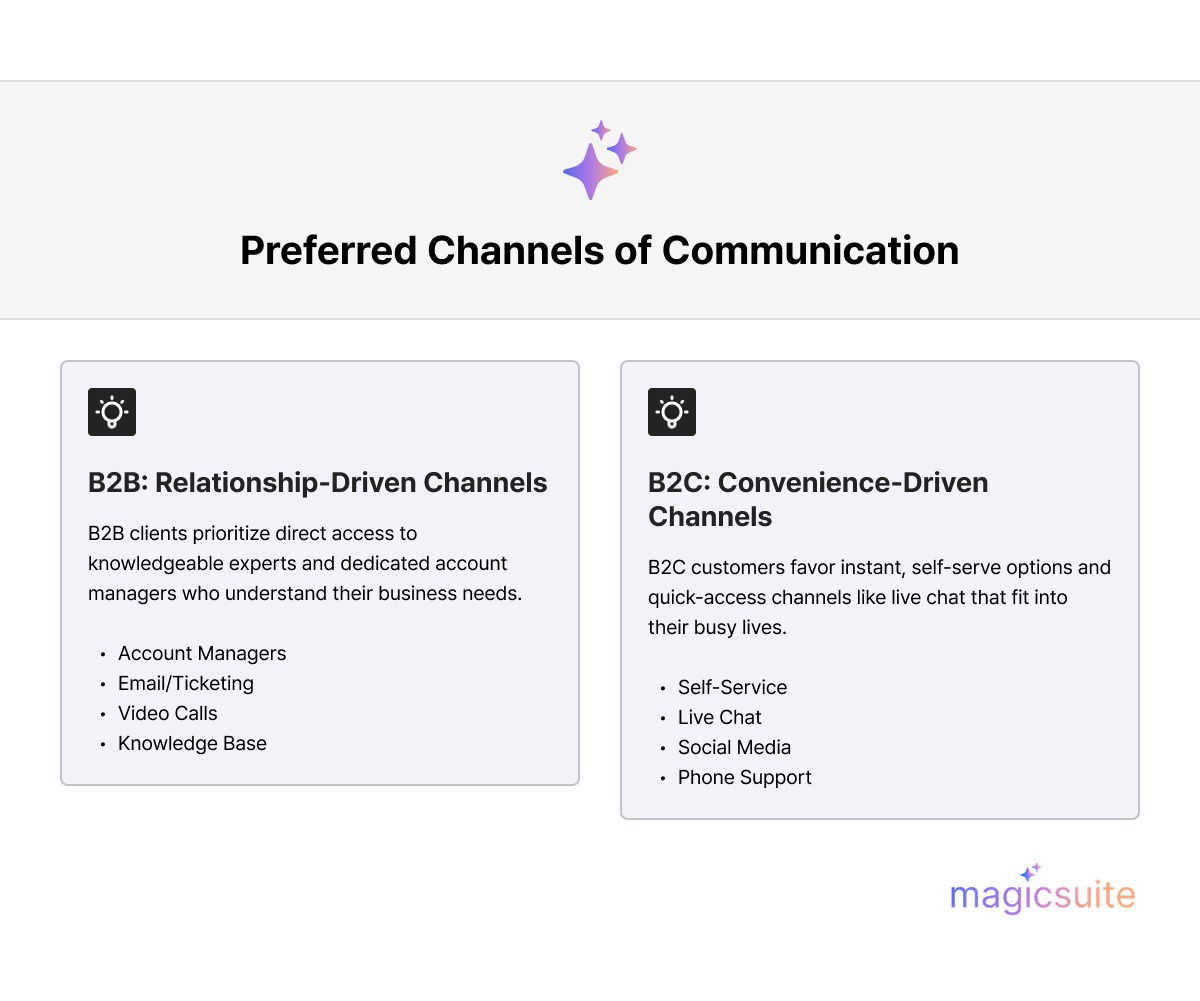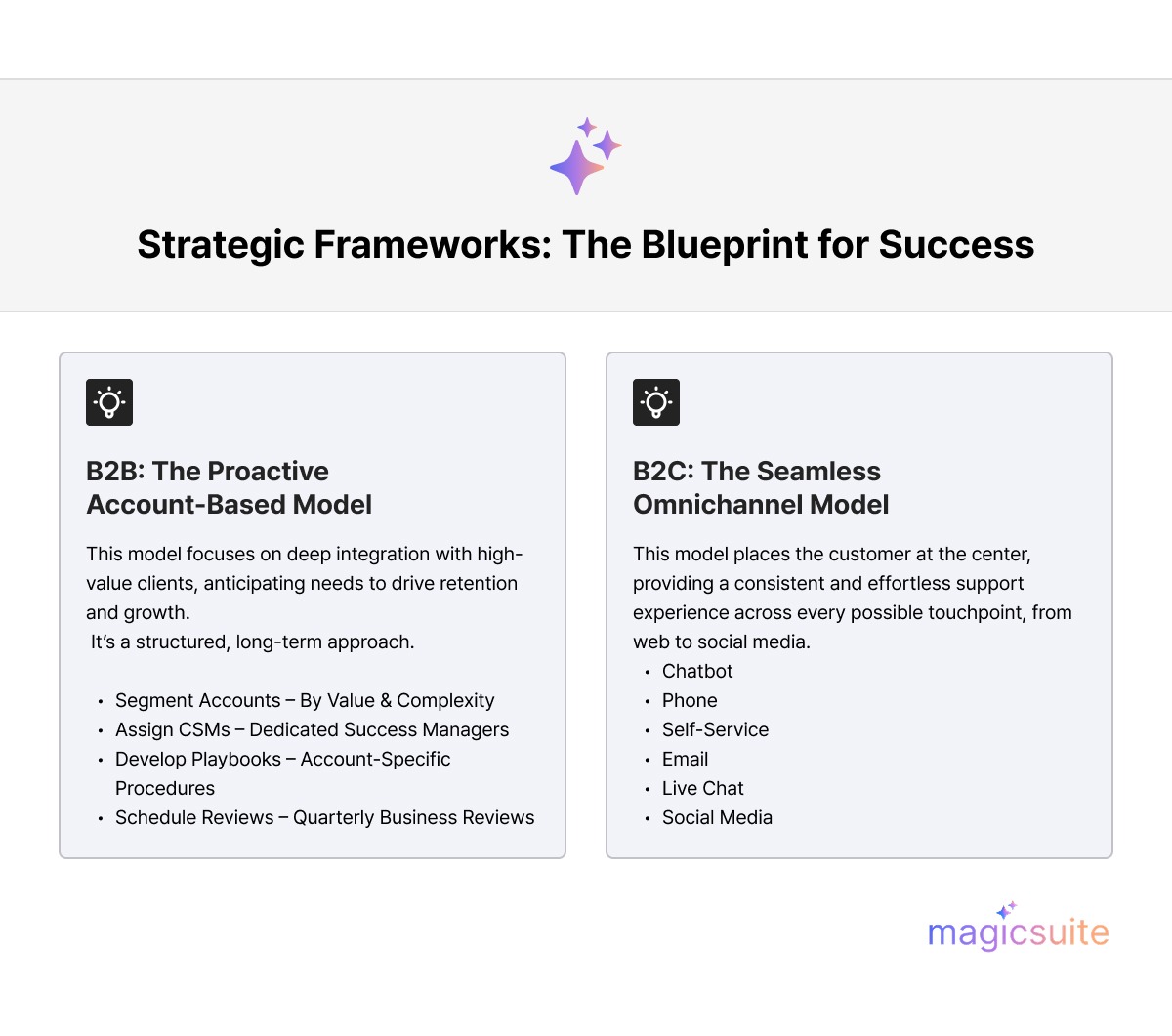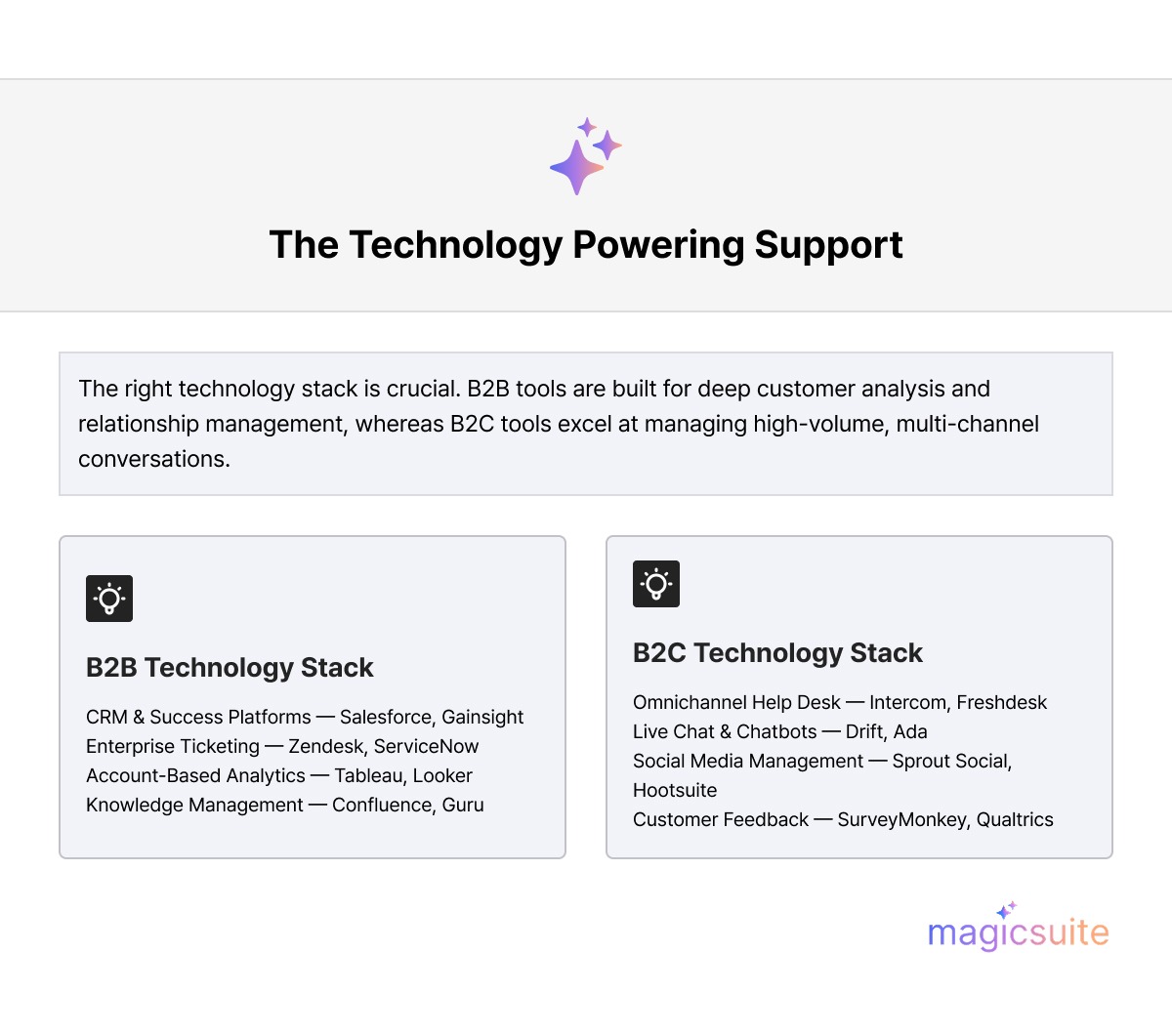Discover the differences between B2B and B2C customer service strategies. Learn response times, support channels, metrics, and implementation frameworks for business success.

Stop helping all customers the same way! A customer service plan that makes a shopper happy will likely make a business client angry. The difference between B2B (business-to-business) and B2C (business-to-consumer) service is huge. It comes down to who you are helping, how big the problems are, and how much money is involved. To give good support, you must know these different worlds. This guide breaks down the main differences in what customers expect, how your team should work, and what makes your support successful.
B2B customer service deals with complex, high-value deals. These take longer to close. One B2B customer might bring in thousands or millions of dollars each year. For example, Salesforce gets over $50,000 per enterprise customer for its CRM solutions. B2C customer service focuses on individual shoppers. They make smaller purchases more often. Amazon Prime members might buy dozens of items throughout the year. Each purchase needs quick, easy support.
B2B relationships last for years. Companies like IBM and Accenture keep clients for decades. They use dedicated account managers to build strong partnerships. B2C interactions are usually shorter and more transactional. However, subscription services like Netflix and Spotify are changing this. They create ongoing relationships with individual users.

B2B Response Standards:
Example: Shopify Plus gives enterprise merchants dedicated success managers. They provide 24/7 priority support with responses under one hour for critical issues.
B2C Response Standards:
Example: Zappos answers customer calls within 20 seconds. Their agents can spend as much time as needed. Their longest call lasted over 10 hours.

B2B Channels (Priority Order):
Companies like Slack and Microsoft Teams offer enterprise customers dedicated Slack channels or Teams spaces for direct communication with support teams.
B2C Channels (Priority Order):
Apple successfully combines multiple B2C channels through its Genius Bar (in-person), support app, chat, and phone support, allowing customers to choose their preferred method.
B2B Personalization:
Example: HubSpot assigns customer success managers who understand each client's marketing strategy. They provide quarterly business reviews and strategic recommendations.
B2C Personalization:
Example: Netflix uses viewing history to personalize support. Agents can reference specific shows or issues related to the user's viewing patterns.
Check this out: 5 Proven Ways to Use AI Personalization in Marketing

1. Account-Based Support Model: Assign dedicated teams or individuals to high-value accounts. According to a Gartner study, companies with dedicated account management see 23% higher customer retention rates.
Implementation Steps:
2. Proactive Support and Success Management Don't wait for problems—anticipate needs and prevent issues before they arise.
Best Practices:
Example: Zendesk's Customer Success team monitors health scores combining product usage, support ticket volume, and satisfaction metrics. When scores drop, they proactively engage to understand and resolve underlying issues.
3. Technical Expertise and Specialization B2B support teams require deep product knowledge and often industry-specific expertise.
Requirements:
4. SLA-Driven Support Infrastructure: Establish clear service level agreements with defined response and resolution times.
Typical B2B SLA Structure:
1. Omnichannel Support Excellence: Let customers switch from chat to phone easily. Do not make them repeat themselves.
Implementation Steps:
Example: Sephora's omnichannel approach allows customers to book in-store appointments online, get product recommendations through their app, receive support via social media, and access their purchase history across all platforms seamlessly.
2. Self-Service Optimization: Most people want to find answers fast on their own. According to Microsoft's State of Global Customer Service Report, 90% of consumers expect organizations to offer online self-service portals.
Example: Airbnb's Help Center resolves over 70% of customer inquiries through self-service articles, videos, and automated tools before customers need to contact a support agent.
3. Speed and Efficiency Prioritize rapid response times and first-contact resolution.
Benchmarks:
4. Emotional Intelligence and Empathy B2C interactions require strong emotional intelligence, as individual consumers often have emotional attachments to purchases and experiences.
Training Focus:
Example: The Ritz-Carlton empowers every employee to spend up to $2,000 per guest to resolve issues without manager approval. It demonstrates trust and commitment to emotional satisfaction over rigid policies.

Essential Tools:
Helping businesses takes different, special computer tools. B2B problems are complex and last longer, so you need a system that tracks everything.
Essential Tools:
Integration Priority: Unified customer view across all touchpoints with automated routing and AI-powered assistance.

Primary KPIs:
Calculation example: Customer Health Score = (Product Usage × 0.3) + (Support Satisfaction × 0.2) + (Engagement × 0.25) + (Financial Health × 0.25)
Primary KPIs:
Example benchmarks:
More on Customer Support KPIs You Should Track to Measure AI Impact
Atlassian transformed its B2B support by implementing a tiered support model with dedicated Technical Account Managers (TAMs) for enterprise customers. Their approach includes:
Results: Enterprise customer retention increased to 98%, with Net Revenue Retention exceeding 120%.
Amazon revolutionized B2C customer service through:
Results: Customer trust scores consistently rank Amazon as #1 in customer service among major retailers, with over 200 million Prime members globally.
Modern customer service increasingly leverages AI to enhance both B2B and B2C experiences. MagicSuite.ai enables businesses to:
For B2B:
For B2C:
See how AI-powered support can work for your business—whether B2B or B2C. Try MagicTalk for free and experience intelligent customer service automation that adapts to your specific needs. No credit card required.
B2B and B2C customer service strategies are different. They reflect different customer expectations, relationship dynamics, and business models. B2B success requires deep partnerships, proactive management, and specialized expertise. B2C excellence demands speed, convenience, and emotional intelligence. However, both approaches share common success factors:
Whether you serve businesses or consumers, the fundamental principle remains the same.
About MagicSuite.ai: MagicSuite.ai provides AI-powered customer service solutions. We help businesses deliver exceptional support at scale. Our platform adapts to both B2B and B2C requirements. It automates routine inquiries while ensuring seamless human handoff for complex situations. Learn more about how MagicSuite.ai can transform your customer service strategy.

Hanna is an industry trend analyst dedicated to tracking the latest advancements and shifts in the market. With a strong background in research and forecasting, she identifies key patterns and emerging opportunities that drive business growth. Hanna’s work helps organizations stay ahead of the curve by providing data-driven insights into evolving industry landscapes.